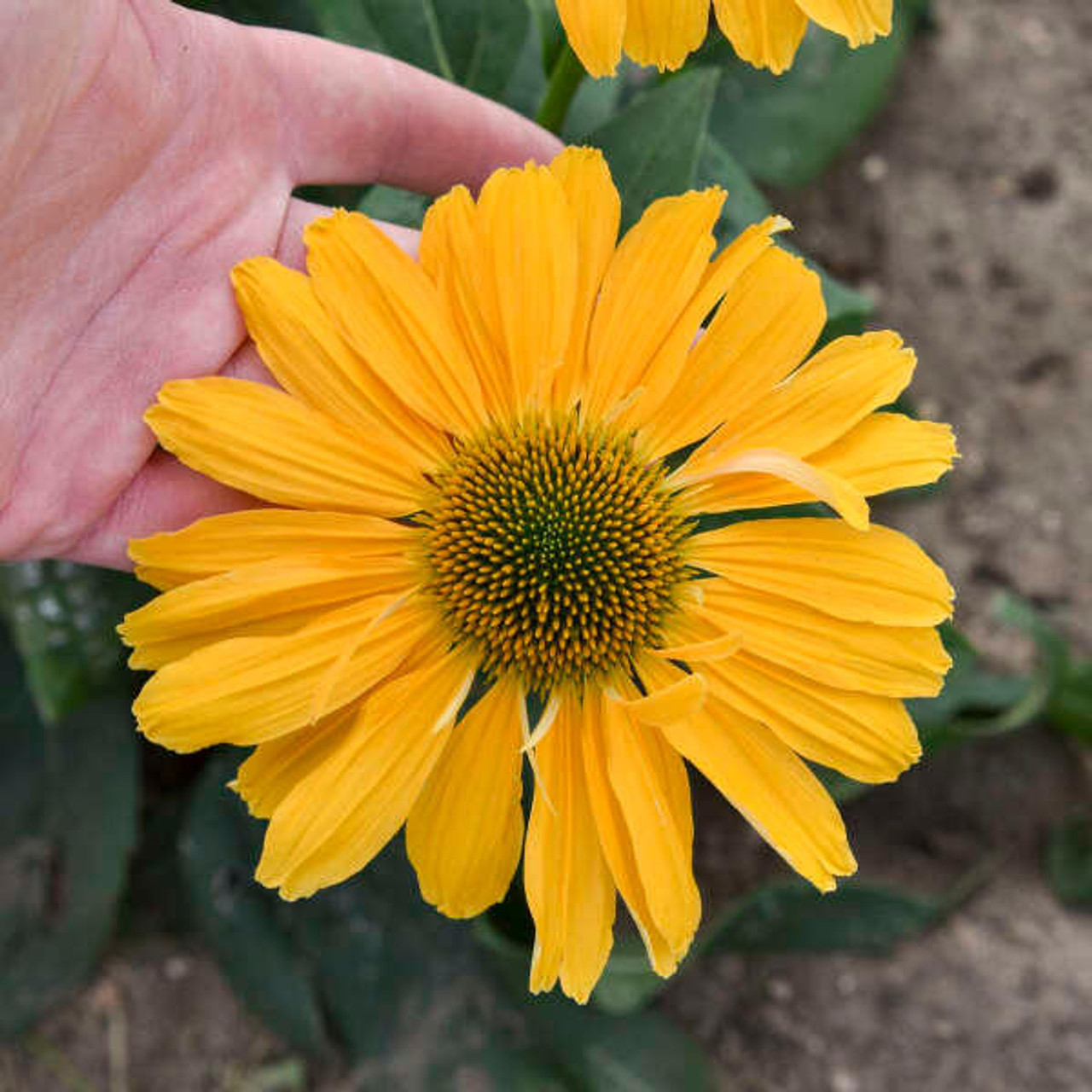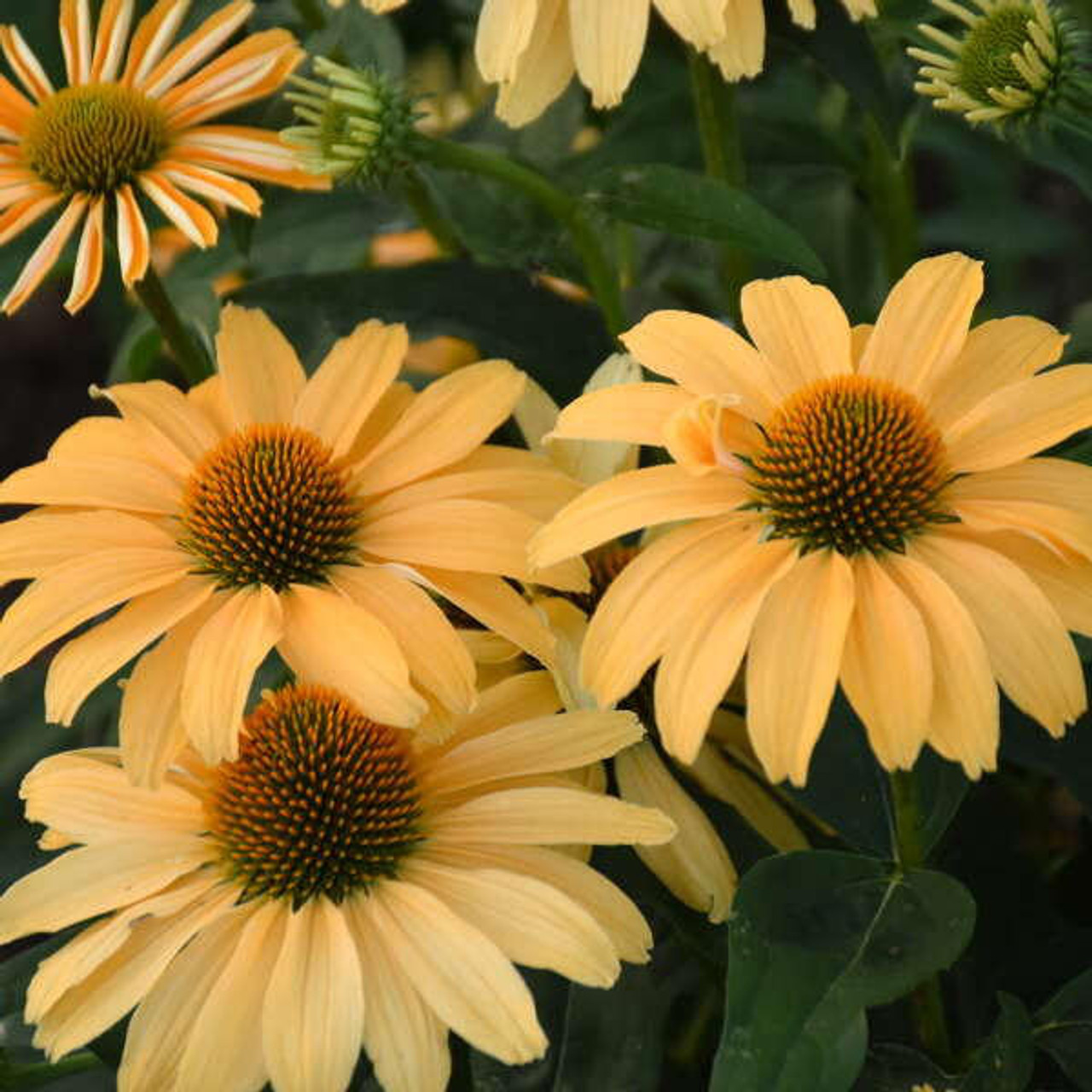Product Description
Echinacea 'One in a Melon' PP35153 CPBRAF (30)ct Flat
COLOR CODED® Collection
Common Name: Coneflower
Melon-colored flowers and matching melon cones. At 5-5½" wide these are among the largest flowers in the collection. Petals are held horizontally and overlap for maximum display. The cantaloupe flower color is lighter than 'Orange You Awesome' and not a true yellow like 'Yellow My Darling'.
COLOR CODED® Echinacea are produced vegetatively from tissue culture, so all plants will be identical in color and habit. These varieties were selected for their excellent basal branching, flower performance, large flower size, and horizontally held petals. Enjoy these as late summer interest for your garden. These are perfect pollinator magnets and during late fall to winter the seed heads will serve as food for birds.
Praised for their cheerful brightly colored flowers, coneflowers are a mainstay in today's garden. Be sure to leave some spent blooms on the plants in the fall because their seeds provide winter food for finches and other birds. The dried seed heads also provide architectural interest in the winter.
Coneflowers like it sunny and hot. Though they will tolerate light shade, fewer flowers will be produced, and the plants will be weakened. Light, loamy soils are best, but coneflowers will grow in any well-drained soil. Once established, they are quite drought tolerant. If properly cared for, they will form attractive colonies and will live for many years.
Height: 24.0-26.0 Inches
Spread: 18.0-20.0 Inches
Hardiness Zones: 4,5,6,7,8
Flower Color: Yellow shades
Foliage Color: Green shades
Full Sun to Part Shade
Low to Average Water Needs
Poor to Fertile Soil Quality
Bloomtime: Midsummer to Late Summer, Early Fall
Deer Resistant
Seasonal Interest: Dried Seed Heads
Growth Rate: Medium
Border Plant, Container, Cut Flower, Dried Flower, Easy To Grow, Fragrant Flowers, Mass Planting
A Sweet Addition to Your Garden
The Echinacea 'One in a Melon' has become a favorite among gardeners, captivating enthusiasts with its unique color and resilience. This coneflower boasts large, vibrant melon-colored flowers that bloom from mid to late summer, adding a cheerful touch to any garden. This article delves into the characteristics, care requirements, and uses of this delightful plant.
Characteristics The Echinacea 'One in a Melon' is a hybrid perennial that displays an upright habit and excellent branching. It typically reaches a height of 24-26 inches with a spread of 18-20 inches. Its most captivating feature is its 5-5½ inch wide melon-colored flowers with matching melon cones. The petals are held horizontally and overlap, creating a full and captivating display. The unique cantaloupe hue of the flowers comes from a blend of yellow and orange. It is lighter than 'Orange You Awesome' and not a true yellow like 'Yellow My Darling'. The bright green foliage provides an excellent contrast to the cheerful blooms.
This variety is part of the Proven Winners "Color Coded" collection, a series of Echinacea known for their vibrant and consistent colors. Other colors in the collection include 'Yellow My Darling', 'The Price is White', 'Orange You Awesome', 'Frankly Scarlet', 'The Fuchsia is Bright', and 'Knock 'em Red'. What sets 'One in a Melon' apart is that it is clonally produced from tissue culture. This ensures that all plants will be identical in color and habit, providing predictable results for gardeners.
Interestingly, the name "Echinacea" originates from the Greek word "echinos," meaning hedgehog or sea urchin, referring to the spiky central cone of the flower.
Care Requirements Echinacea 'One in a Melon' thrives in sunny and hot locations with well-drained soil. It prefers to be planted in locations with moderately fertile, well-drained soils and does not perform well in locations with poor drainage or soils that remain constantly damp. While it tolerates light shade, it performs best in full sun, producing more flowers and exhibiting greater vigor. It is adaptable to a range of soil types and pH levels, from acidic to alkaline. Once established, it is quite drought tolerant. Here is a more detailed guide to caring for your Echinacea 'One in a Melon':
- Planting: Plant in spring or early fall, allowing time to establish before extreme weather.
- Watering: Water regularly during the first growing season to establish a deep, extensive root system. Once established, water occasionally during prolonged dry spells.
- Fertilizing: Apply a general-purpose fertilizer in early spring and mid-summer to support healthy growth and blooming. Avoid over-fertilizing, as this can make the plant more susceptible to crown and root rot.
- Pruning: Deadhead spent flowers to encourage more blooms. However, leaving some spent flowers on the plant in fall provides food for birds, particularly finches, and adds winter interest to the garden. In early spring, before new growth begins, cut back the plant to about 4-6 inches to promote vigorous new growth.
Pests and Diseases While generally hardy, Echinacea 'One in a Melon' can be susceptible to Aster Yellows disease. This disease is caused by a phytoplasma transmitted by the six-spotted leafhopper. Affected plants may show yellowing of the leaves, reddening, stunting, and deformed flowers.
Uses Echinacea 'One in a Melon' is a versatile plant with a variety of uses in the garden:
- Attracts Pollinators and Birds: The flowers are highly attractive to pollinators like bees and butterflies. Leaving the spent blooms on the plant provides winter food for birds, who enjoy picking seeds. This not only provides sustenance for the birds but also adds a dynamic element to the winter garden.
- Deer Resistant: This plant is resistant to deer, making it a good choice for gardens where deer are a problem.
- Versatile Landscaping: Its medium height and vibrant color make it ideal for borders, mass plantings, and container gardens. It can also be used as a cut flower or dried flower.
- Adds Winter Interest: The dried seed heads provide architectural interest in the winter garden.
- Xeriscaping: This coneflower is drought tolerant once established, making it a suitable choice for xeriscaping, a landscaping method that reduces or eliminates the need for supplemental water from irrigation.
Echinacea 'One in a Melon' is a delightful addition to any garden. Its unique melon-colored flowers, hardiness, and versatility make it a favorite among gardeners. Whether you are looking to attract pollinators, add a pop of color to your borders, or create a low-maintenance garden, this coneflower is an excellent choice. With its easy care requirements and stunning blooms, Echinacea 'One in a Melon' is sure to bring joy to your garden for years to come.
Why not add this vibrant coneflower to your garden this year? Imagine the cheerful blooms attracting butterflies and bees to your yard, and the delight of watching birds feast on the seed heads in the winter. Consider pairing it with other drought-tolerant perennials like sedums, Russian sage, or ornamental grasses for a stunning and water-wise display.
Thirty (30) plants per flat (or tray). Approximate Plug Measurements: 3 inches deep x 2 inches wide.
Other Details
The most important part of the plant is its root system. Healthy roots are the foundation of a healthy, vibrant plant. The type of plug container used is based on the specific needs of the plants. Perennials offered as bare root traditionally perform better when planted as bare root.Planted in a specialized mix, potted plants have well established root systems. Top growth stage will vary depending on the current life cycle and time of year when shipped. In Winter and early Spring dormant plants may be shipped. Dormant plants may be planted right away, even before the last frost date.
Most bare root varieties are field grown for at least one season, though Hemerocallis and Hosta are grown for two seasons. The bulk of the soil is removed during the harvesting process and the tops of most varieties are trimmed back to the crown. They are graded, packed in shredded aspen or sphagnum moss and stored in freezers until ready to be shipped.
See our Container Sizes and Bare Root Perennials pages for more information.
Plant information and care is provided in the Overview section, Plant Genus Page and general information is provided in the Planting Care & Guides. Additional questions can be asked on each Plant page.
Plant Spacing: Using the maximum mature spread or width of a plant to guide spacing, ensures space to grow to full size. To fill an area sooner, plant them closer together. Just remember, future thinning or transplanting may be needed.
Water: Keep a close eye on newly planted perennials, especially throughout the first growing year. Most early plant loss is due to too much or too little water!











